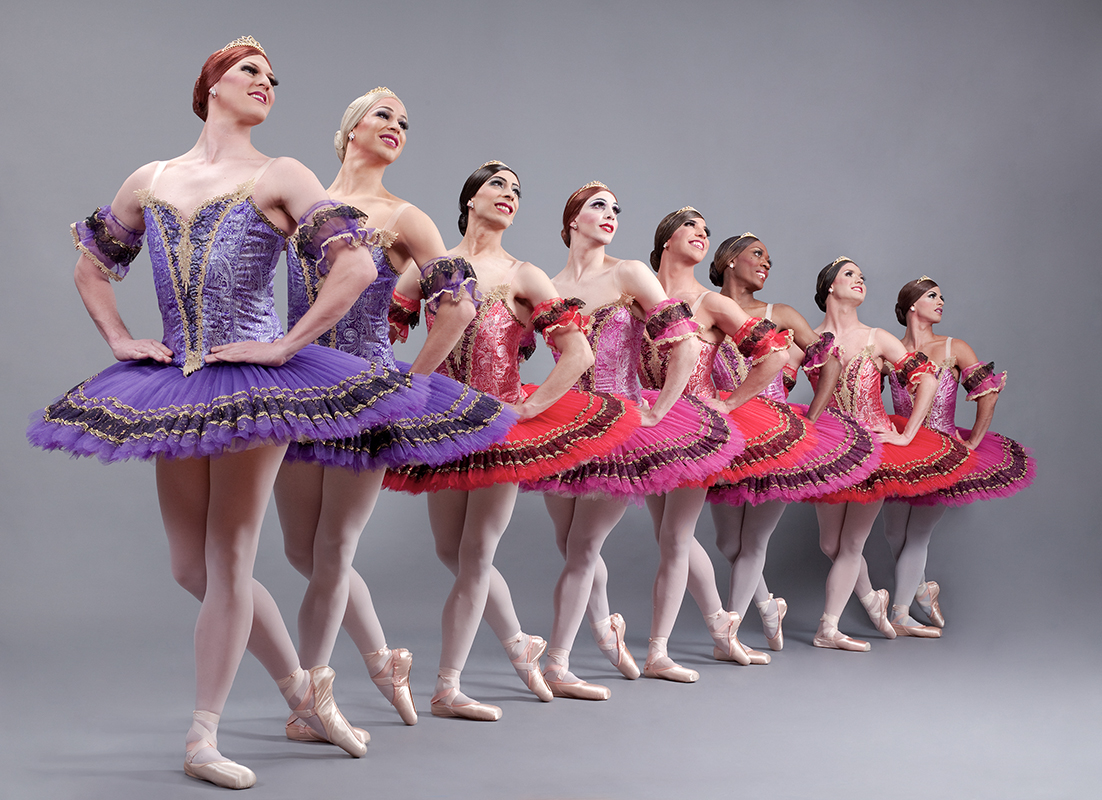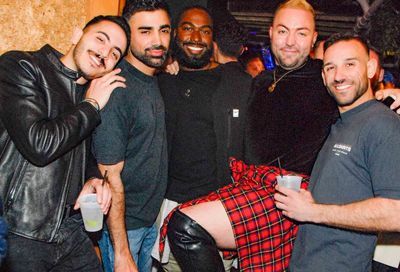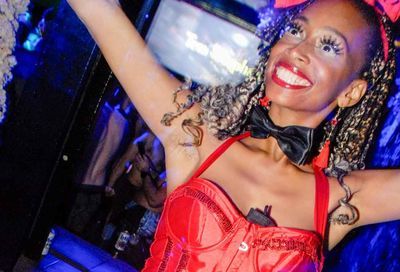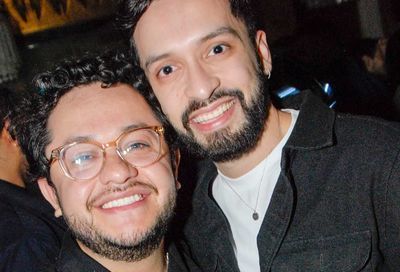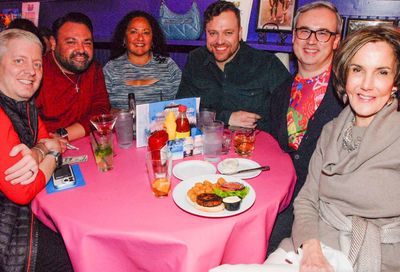Moving History
Choreographer Dana Tai Soon Burgess Traces Memories of Korean-American Immigration
Photography by Todd Franson
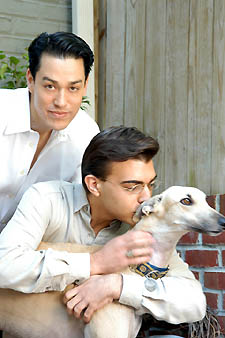 Burgess with his partner, Aaron Modiano, and Pico the greyhound. |
History is so much more than a simple series of times and dates and places. History is a fluid thing, a series of stories that intertwine and illuminate, a cycle that carries meaning from one generation to the next. History is the process of making change and preserving tradition.
History is the story of people in motion.
In 1903, thousands of people aboard steamships from Asia began that story of Korean American immigration. Arriving in waves in Hawaii to work on plantations, those families and the generations that followed created an integral part of the American experiment. That one-hundred year history is being celebrated by the Smithsonian Asian Pacific American Program’s 2003 Korean American Centennial Commemoration.
A fourth-generation Korean American, Dana Tai Soon Burgess has created a story of his own family’s journey to America, a history told through the motion of dance. On November 6 and 7, his dance company will debut his specially commissioned work Tracings at the Kennedy Center Terrace Theater.
Burgess, 35, welcomed the chance to explore his family’s history through art and create a world that tells their story through motion and memory.
“That’s a large part of why I choreograph,” he says. “That somehow the world that I can create on stage is just as real as you and I.”
The son of artists and professors — his parents both teach in the well-known artistic enclave of Santa Fe, New Mexico — Burgess has followed a similar path, creating an acclaimed body of work as a choreographer and dancer, as well as teaching his art at George Washington University. His path has diverged somewhat, though, as he continues to build his life with his partner, Aaron Modiano, in Washington’s Palisades neighborhood.
And so it is that history continues to change and grow in unexpected ways.
History always stays in motion.
METRO WEEKLY: Describe your upcoming performance at the Kennedy Center.
DANA BURGESS: Tracings is a co-commission between the Smithsonian and the Kennedy Center’s Etcetera series. It’s part of a year-long celebration of the Korean centennial — the one hundred years of Koreans in the Americas. My family on my mom’s side came over in 1903 as part of that original immigration from Korea. What’s great is that these institutions asked me to create a work which could in some way be dedicated to that perspective. Obviously, this is a once in a lifetime project, to be able to honor family members and those first immigrants. But I didn’t want to make it a travelogue — it’s not a history narrative of what historically happened. It’s what I call a memory montage, an elaboration upon images that I experienced as a child, the components remembered from a family experience through multiple generations. I don’t think that we learn about our own family histories in a linear format. They’re revealed like anagrams, through different stories and different images as you’re growing up. That’s how I wanted to create this work — it just keeps flowing, there’s something in each section that triggers the next memory.
MW: Why is 1903 the specific year for Korean immigration here?
BURGESS: That’s literally when the first wave of immigration brought Koreans to the Americas, specifically to Hawaii to be sugarcane and pineapple plantation workers. There were special contracts that paid for their passage from Korea and a very basic home, and they would work off the cost of that contract before they could begin to make money. It was an important way for Koreans to be able to get out of the country during that time period, because the Japanese were closing down the country. Within a few years of their arrival in America, Korea ceased to be. It was enveloped by Japan. The Korean language was taken out of schools, everybody had to change their names. A lot of the Koreans who came over thought that they would go back when the political situation got better, but it never got better. So you have these families that stayed for four generations, like mine.
MW: Did you grow up learning about this history, or is it something you learned later?
BURGESS: I hadn’t realized [until recently] that my family came in the first months of the 1903 immigration, but I knew that my grandfather was a foreman on a pineapple plantation, and I knew that my mom had worked picking pineapples. I heard stories about those lives, but it never revealed itself completely until I researched this project. What were the working conditions like, what were the reasons that people came over, why did they stay, all these historical and political issues. It was wonderful to have this time to better understand my own family history and where it fit into a larger context of the American tapestry. My mother actually does a cameo in the show, which is very exciting.
 |
MW: As you learned more about the history, did you find you had learned more about your mother than you had expected?
BURGESS: I’m always discovering more about family members — relationships just deepen as you get older. Understanding that they had a life as well, that they were 35, 14, and 8-years-old, and somehow all that is still in there at 73. There’s a deep, rich history that resides there. And as I grow older, I have a more three-dimensional relationship with both my parents.
MW: How do you find the dancers for your company?
BURGESS: I don’t audition any longer, because I feel that at an audition you can be very misled by accident. In an audition a dancer may pick up material fast and really crank it, but you bring them into a rehearsal and the personality might not gel with the rest of the group. Now I invite a potential dancer to the company for a month’s time period, and after a month we either bring them into the company or we don’t. It’s all agreed upon in advance, because personality is very important. And also being a thoughtful, intellectual dancer, not just a good technician, is what I look for. Once you get to the professional tier of dancers, then everybody is very similar. You can kick your leg the same height, you can fall to the floor the same way. What is different is the personality and the thoughtfulness that the individual brings to the choreography, and that’s what I look for.
MW: Your company’s website mentions fusing the “creative essence of eastern and western dance.” How do you define Western movement and Asian movement in dance, and how you’ve brought them together?
BURGESS: Because I’m Amerasian, that’s my perspective. When I create work it comes from my subconscious, and my subconscious world has a vocabulary that is a combination of eastern and western movement, just like I’m a combination of eastern and western genes. In western modern dance — and in ballet — as well there’s a lot of usage of the legs, a lot of dropping of the weight, and larger gross motor skills. In the east there’s an interesting juxtaposition between smaller gestural forms and stillness that you don’t necessarily see as often in western modern dance. I have a martial arts background form when I was a child, so that [form of movement] is always there as well.
MW: What got you started with that?
BURGESS: When I was seven or eight, I asked my parents if I could play the piano. They were like, no way, you can get yourself into martial arts classes. [Laughs.] I didn’t want to, but as soon as I got into the classes I loved it so much. I loved the joy of moving. One day my father said, why don’t you take dance classes? So I did and I got hooked.
 |
MW: With parents who were both professors and artists, did you have a liberal upbringing, or a mix of liberal and conservative mixture?
BURGESS: Very liberal. Well, liberal in terms of artistic aesthetic. Having both parents come from immigrant backgrounds made it in some ways conservative as well, when it comes to values in general. But I think that’s because they’re older. My father is 80, my mom’s 73 — that’s another whole generation of morality, of what’s acceptable.
MW: I assume you’re out to your parents.
BURGESS: I am, and they know Aaron. My mom will arrive next week and she’ll be staying here. I think that the only issue that they ever had with my lifestyle is that they wanted to make sure that I was with a good person — that’s the hardest part of anyone meeting anyone’s parents. So they’ve been very supportive.
MW: Did you come out to them, or was it something they figured out?
BURGESS: I told them. You would think they would have figured it out, but they didn’t. [Laughs.] Denial, a river in Egypt, that sort of thing. When I was a teenager I just told them that I was attracted to men and that was when everything sort of hit the fan. Then it just calmed down, and we didn’t really have to discuss it much until Aaron. I wanted them to understand that I was moving into the next phase of my life with someone special.
MW: Looking at this project and the history it covers, how would you say the Korean American experience differs from the experience of other Asian American communities that have immigrated to America?
BURGESS: It’s interesting because there was a wave of early immigration, and then a long period of no immigration. Then around the Korean war immigration begins again. So there are generations of families like mine that are cut off from the new American experience of Korea, and so they hold on to traditions in a very different way. The earlier that you come over, the more that you hold on to an older, traditional form. For families who came over in 1903 the memories and shared concepts of what Seoul is are very different than for a family that came over in the 1970s.
The first time I went to Korea, I remember thinking, this isn’t the Korea I’ve been hearing about. These people all have a bazillion cell phones and everybody’s hooked up to internet. It’s just funny how everything changes.
MW: How has being Asian American affected your experience in the gay community?
BURGESS: I think things have changed a lot in Washington. When I first moved here, it felt like there were very few Asians who would be out in the bars. Now there’s this sudden generation of very out, very visible Asian men. I think a lot of the stereotypes are being broken down. It’s not like everybody’s considered an FOB — fresh off the boat — or as submissive Asian males. It’s not like that anymore, which is awesome.
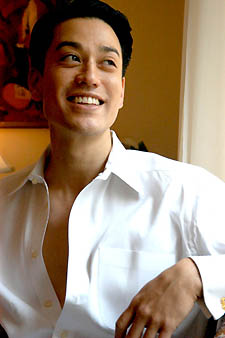 |
MW: Did you find yourself being stereotyped that way in the gay community?
BURGESS: Well, I saw friends of mine deal with that more, and really struggle with certain identity issues around that. It’s funny how there are different perspectives of beauty, and what’s handsome and what’s attractive. Some people really go for petite Asian guys, but never having been a petite Asian guy and not having to live with that stereotype maybe I was able to sort of move more freely through different situations.
But yeah, I’ve had odd questions asked, or odd assumptions made. I had this one guy, years ago, who when I told him my name was Dana said, “Well, that doesn’t sound like a very Asian name.” And then I had another person ask, “Are you Oriental?” No, the rug on my floor is Oriental. Oriental is some colonialist word from the past — it’s just bizarre. So yeah, those things happen, but I think that the more people are honest and upfront and are well-educated, then things change. It all comes down to education.
MW: How different is your life now from what you expected when you told your parents that you were gay?
BURGESS: Santa Fe has a very strong gay population, so I’ve been able to have really wonderful role models and mentors along the way, who have been great and continue to be really wonderful friends. In terms of coming out and my career, I think that our biggest limitation in terms of self-actualization is our own inability to dream on a very grand scale. The main thing that often can hold us back is the inability to see a larger picture for ourselves.
Tracings debuts November 6 and 7 at the Kennedy Center Terrace Theater, at 7:30 p.m. Tickets are $25, available online at www.kennedy-center.org, or by phone at 800-444-1324. For more information about the Smithsonian Asian Pacific American Program and the 2003 Korean American Centennial Commemoration visit www.apa.si.edu. For more information about Dana Tai Soon Burgess & Co., visit www.movingforwarddance.com.
Support Metro Weekly’s Journalism
These are challenging times for news organizations. And yet it’s crucial we stay active and provide vital resources and information to both our local readers and the world. So won’t you please take a moment and consider supporting Metro Weekly with a membership? For as little as $5 a month, you can help ensure Metro Weekly magazine and MetroWeekly.com remain free, viable resources as we provide the best, most diverse, culturally-resonant LGBTQ coverage in both the D.C. region and around the world. Memberships come with exclusive perks and discounts, your own personal digital delivery of each week’s magazine (and an archive), access to our Member's Lounge when it launches this fall, and exclusive members-only items like Metro Weekly Membership Mugs and Tote Bags! Check out all our membership levels here and please join us today!




